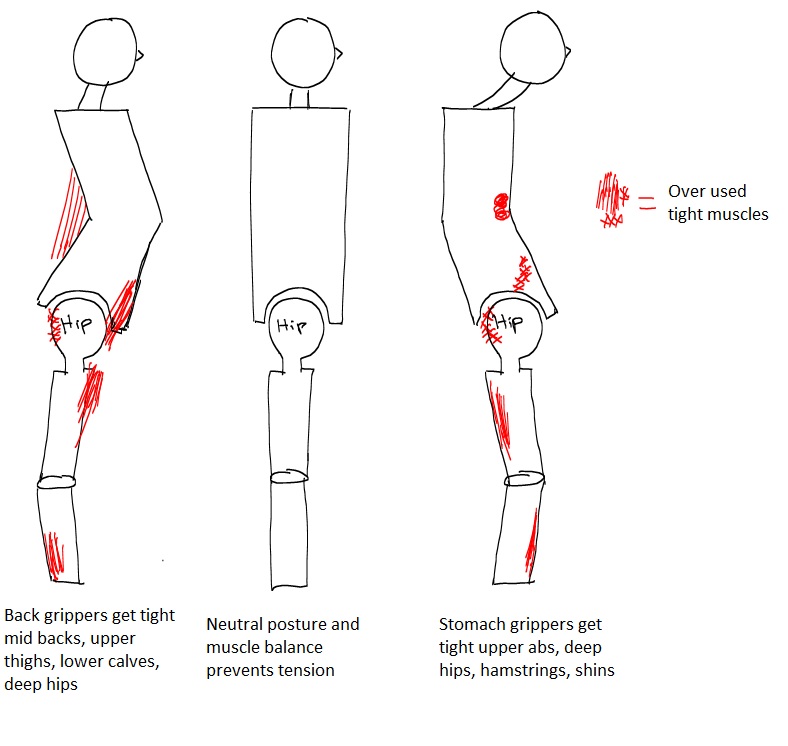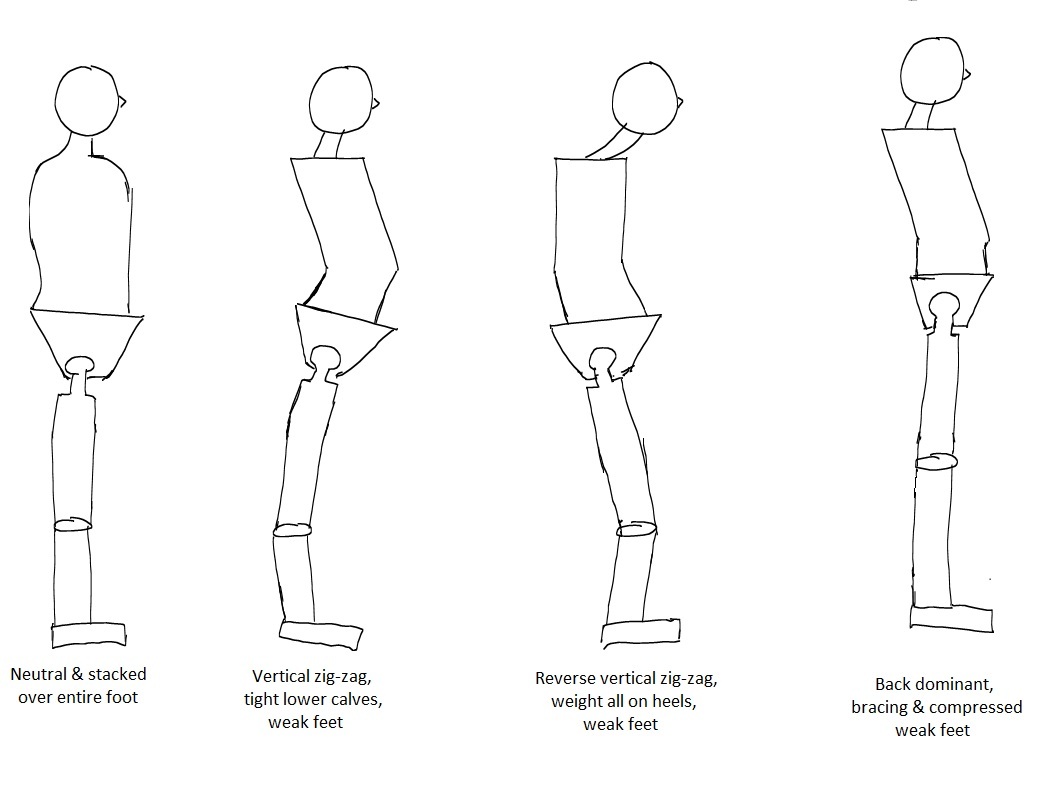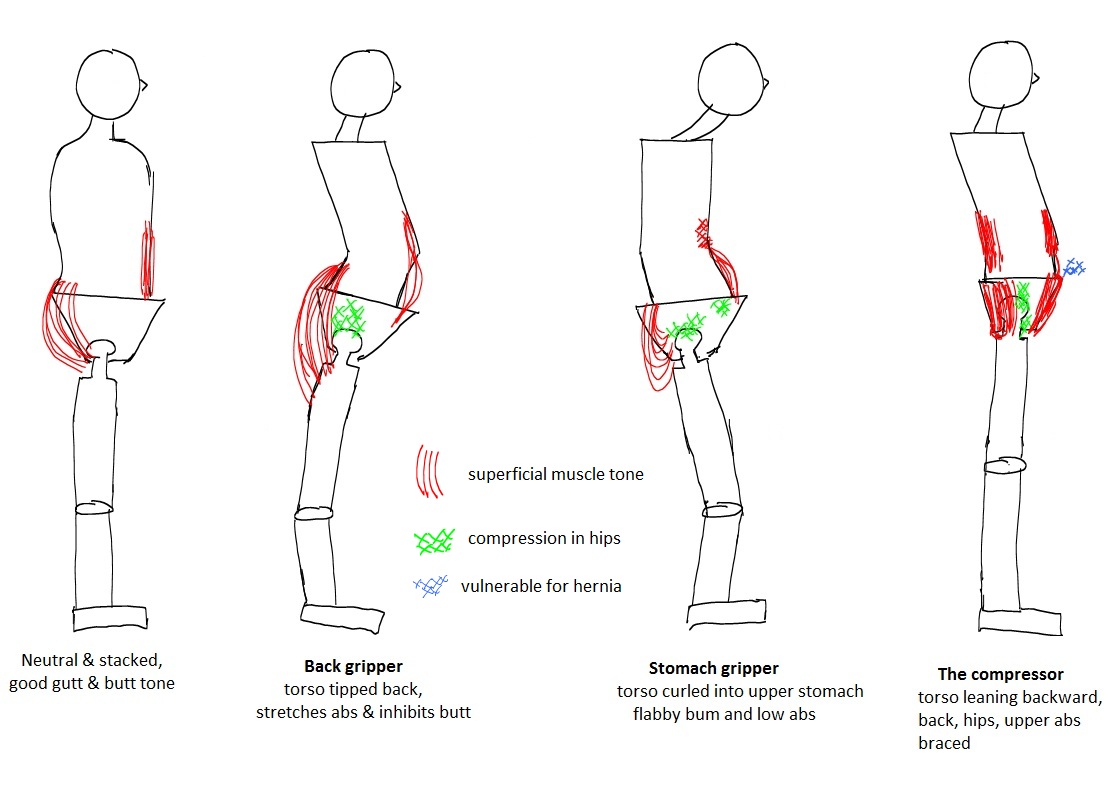
Why does your hip hurt if you didn't do anything to injure it?
The short answer…you probably did a whole bunch of things to it, every day, for years and had no idea that you were doing something wrong.
The full answer…..read below…Your hips are the centre of your universe. They are the connection of your upper and lower bodies and most people have no idea where they are or how to use them properly. It is a strange thing to suggest that someone doesn't know where their own hips are, but take it from a guy that teaches people to move all day….most people have trouble distinguishing their hips from their pelvis or how to move in a strong, coordinated way through their mid-section.
There are way more moving parts to your body than you have the capacity to focus on at any given time so the best way to explain this to you is to simplify your body down to two pieces and then add on layers as you understand. Start by thinking of your body as two wooden blocks with a round hinge connecting them in the middle. Now remember that gravity pulls everything downward and imagine trying to balance the upper piece on the round hinge by holding onto the lower piece. There are three likely scenarios:

To give these pictures some life, let's add a head and neck onto them and see what happens. You also need to understand that your brain has a head righting reflex that wants to keep your head and face looking straight forward, so if one part of your body is persistently leaning one direction your head and neck will accommodate for it.

So far we have block men with hips and necks; an upper body, a lower body and a head. The above pictures are three common postural types, but we all know the human body has more joints in it. Let's add an upper body hinge in first. Your spine has 24 vertebrae in it all with their own hinges, but the most common hinging point is around the middle of your torso so lets add one hinge there and see what happens to posture.

You can start to see in the above drawings where people would be prone to getting really tight in certain areas based on their posture. The further a person tends to deviate from the straight, "good" posture the harder time they will have moving properly in their big hip hinges and the more they will beat up on the joints over time. Let's give our block people knees now and see what happens:

These people that aren't properly stacked will be very prone to developing chronic tension in very specific areas due to overuse just dealing with gravity and trying to stay vertical.

You might be able to tell by the drawings that how you tend to hold your upper body will have an impact on how you hold your lower body and vice versa; the hips are stuck in the middle and just have to try and figure out how to keep you vertical. More often than not the root cause of hip issues is a product of whole body posture; that being said let's give our people pelvises, ankles and feet. The pelvis can tip anteriorly or posteriorly to add a layer of complexity to your centre while your whole posture can be thrown off by shoes with various levels of heel (click here to see my stance on shoes).


By now I'm sure you are getting the picture of how posture can affect your hips, but let's take a closer look at how these postures actually create pain. The hip is happiest functioning deep in the middle of the socket. Ideally your pelvis balances on top of both hips in a slightly tipped forward position and the muscles on every side of the hip work in a coordinated tug-of-war to keep everything balanced. Unfortunately, as we have seen in the above pictures, the upper and lower body don't always come together in a balanced way and the hip joint gets levered one way or the other.
In 'good' or 'normal' posture your butt (gluteus maximus) works together with your abdominals and your back works together with your thighs. Your gluteus maximus (or the bigger part of your butt) functions optimally when your body is nicely erect. If your pelvis gets too tipped forward or too tipped backward due to postural issues, the glute max just won't work properly and the result is over activity of the deep muscles underneath, namely your piriformis and adductors (inner thigh); these smaller muscles have to work harder to hold the ball in the socket when the glutes aren't firing properly and typically the result is big trigger points and muscular pain. The joint can get very compressed in the socket and/or tend to pinch and rub in the front of the joint. Over time this pattern of muscle over activity and poor movement can lead to wear and tear in the joint, sciatica, pelvic dysfunctions, low back pain, torn labrums and eventually advanced osteoarthritis.
Watch this 60 second video for my demonstration of the hip in the socket.
To have good posture and normal functioning hips the various parts of your body need to work together in a coordinated, strong manner that provides stability and mobility throughout your joints. Unfortunately, due to learned behaviour as a child, genetics, sports, pregnancy, accidents, work and personality we develop various muscle imbalances and postural strategies that may predispose us to pain and injury over time. The tendency is for people to latch on to one or two areas of their body to hold everything up at the expense of everything else. My colleague Diane Lee first introduced me to the concept of butt grippers, back grippers and stomach grippers (click here for more info). Look at the pictures above then stand and look at your side profile in a full length mirror and pick which one most resembles you. These pictures are not all encompassing, but they make up the lion's share of people.
What body type are you:
Normal- Gutt & butt working together- Everything stacked up pretty well
Back Gripper- Weak long butt and abs- Tight upper thighs, deep hips and back- Common in hypermobile women, dancers, gymnasts, post-pregnancy
Stomach Gripper- Weak, flabby butt- tight deep hips, hip flexors, upper abs and chest- Common in elderly, post-pregnancy, post abdominal surgery, tall teenage boys
Butt Gripper/The Compressor- Tight, strong, compressed hips with limited flexibility- Can either have weak back and hinge in back like stomach gripper or be tightly compressed in mid back and hips and prone to weakness in the lower back and lower abdominals- Common in athletic men, personal trainers, etc
These are the most common postures, but people tend to mix and match and find creatively bad ways to hold themselves up. I always like to remind people that just because you can stand, sit, walk and run does NOT mean you do it very well. Your body is fantastic and cheating and compensating during movement and the more it cheats the more things will start to break down and hurt over time; this is very much the case with your hips.
My best advice is to start paying attention to how other people stand around you. Start trying to pick out the butt grippers and back grippers. Look for long big bums and flat saggy bums. Watch how many people are actually leaning backwards as they stand or walk. It may be hard to change how you move, but watching everyone else will give you a keen eye to learn about yourself. No matter what your posture is like or how much pain you may have there is very likely a way to significantly improve it. The best way to start is by following these steps:
1. Start watching other people and practice identifying different body types-Helpful videos: How to Stand and How to Sit
2. Look at the above drawings and pick which one you think best captures you
3. Read my article on being hypermobile and determine what you are
4. Read my article or watch my video: Everything your mother taught you about posture is WRONG
5. Start learning how to move by discovering your hips...
6. Consider finding a physiotherapist that does Intramuscular stimulation (IMS acupuncture) to help release all your tight areas. This will help with pain and posture and just make the whole process easier and faster
I continue to prove on a daily basis that you can in fact teach an old dog new tricks working with 40-60 year olds with posture and pain problems. It is never too late to improve your posture or at very least prevent it from getting worse. The first step is identifying that what you feel is 'normal' may not in fact be the best way to function and start creating awareness of your own body. Your hips are the center of your universe and although you can technically now have them replaced, you will just continue the cycle of beating up on them if your don't address the root cause of how your wrecked the first pair you started with. Take care of your hips by minding your posture and you will have much less physical issues throughout life.
I hope this article helps you, please feel free to leave any feedback or questions in the comments section below.
